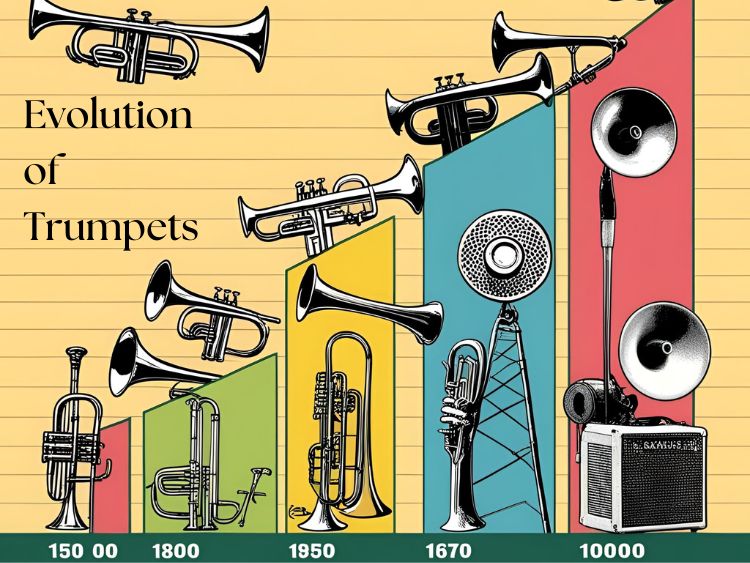The sound amplification has played an important role in communication, functions, warfare and public ceremonies. From raw instruments made up of natural materials to the advanced electronic devices of today’s generation, the evolution of sound amplification showcases both technological success and continuously changing needs. This journey through time explores how human beings have improvised their voices and messages, from the ancient trumpets to the modern megaphones and beyond.
Ancient Beginnings
The ancient forms of sound amplification depended on the natural materials such as horns of animals, shells and woods. These trumpets were used in various civilizations of pre-history to mark important events, alert any kind of danger, and co-operate military moves.
Some of the Egyptians ancient trumpets were found in the tomb of Pharaoh Tutankhamun of 1323 BCE. These metallic trumpets were mostly used in religious and army ceremonies. Meanwhile, the Romans used large curved horns known as the cornu or buccina to exchange commands during fights and in public gatherings. The Norse mythology states of Viking and Gjallarhorn as a legendary horn used to signal important events. It was mostly for warriors and resembled the symbol of power of sound.
The Middle Ages and the Rise of Acoustic Instruments
In the middle ages, the progress of musical instruments greatly enhanced sound projection. Using the large bells, pipe organs and other trumpets enabled religious superiors to convey their message to the public.
The church bells were introduced in Europe during the middle ages. They served as the communicators, summoning people for prayer or warning them. The Herald trumpets were used in royal palaces and military parades. It produced sound efficiently and reached out over far distances. The Speaking trumpet was also created in the 17th century. It was developed of metal or wood to help any person to project their voices across long distances and big spaces, specifically for the soldiers.
The Industrial Revolution and Mechanical Amplification
Groundbreaking advancements were made in the 19th and the 20th century in sound technology. It was motivated by industrial progression and scientific exploration done on a large scale.
Samuel Morland created the stentorophonic in 1671. It was a device similar to megaphone that assisted in amplifying voice. Following the inventions of the Telephone and Phonograph by Alexander Graham Bell and Thomas Edison respectively, the study of sound amplification levelled up along with electric sound transmission. In the late 19th century, Thomas Edison invented the first functional megaphone. It clarified the communicating trumpet designs to produce better amplification of human speech. Finally, during the 20th century, Public Address (PA) systems were enabled due to the electrical amplification. This allowed the voices to be heard by thousands of people over large spaces all at once. PA systems were used for political rallies, sports events and entertainment.
The Electronic Age: Megaphones and Microphones
The 20th century noticed the transition from mechanical to electronic amplification of sound which led to the progress of portable and highly systematic instruments or devices.
-
Carbon Microphones and Amplifiers:
The primary microphone used carbon transmitters enabling sound to convert into electric signals, resulting in a more productive amplification.
-
Electric Megaphones:
The battery-operating and electrically powered megaphones were extensively used by the middle of the 20th century. They were utilised in law enforcement, protesting, sporting events and emergencies.
-
Radio and Loudspeakers:
Radio Broadcasting and Loudspeaker systems took a turnover in mass communication. This provided the revolutionary leaders like Franklin D. Roosevelt and Winston Churchill to reach out to the people worldwide through their voices.
The Digital Era and More
Presently, megaphones and amplification mechanisms are more technologically advanced than ever. It is helping people to benefit from all the digital processing and wireless technology.
-
Smart Megaphones:
The modern megaphones include Bluetooth, voice modulation and AI-powered features to boost clarity and reach.
-
Virtual Amplification:
Digital and Social media platforms now cater as megaphones for person-to-person, amplifying voices all around the world without any physical movements.
-
Future Innovation:
The researchers or scientists still continue to discover new ways of sound projection, such as ultrasonic speakers, bone conduction technology and AI driven real-time voice enhancement. Innovations in directional sound technology are also on their way to development. This allows the sound to be accurately targeted at individuals without causing disturbance to others around. The wearable voice amplifiers and holographic sound projection are originating as promising advancements. It provides more personalized audio experiences in the entertainment industry, virtual reality and assisting communication devices.
Conclusion
Right from the animal horns to the highly-tech driven digital sound systems, the journey of sound amplification has been one of the never ending innovations. What was meant as a signal in ancient times has evolved into a global communication system, empowering industries from entertainment to emergency response. Recently, technology in Artificial Intelligence and Engineering continues to filter sound projection, improvising clarity and accessibility. The multiple methods to amplify voice will continue to shape societies, empower politics and run cultural transformations in ways we have yet to imagine, filling up the gaps in communication and developing new chances for human connectivity.




